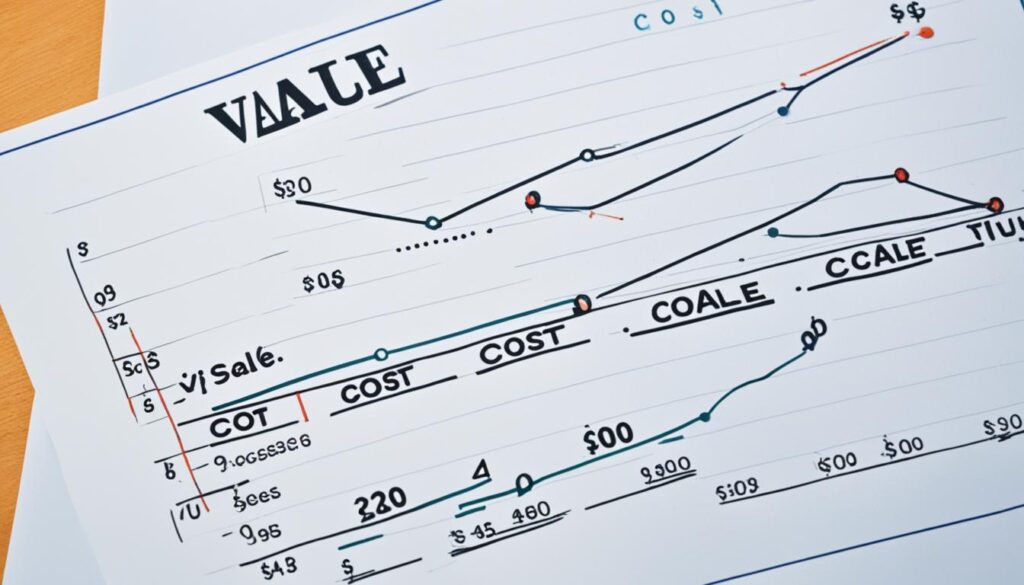Category management started in the late 1980s. It has changed how businesses work. By organizing products by what customers need, it aims to boost competition and collaboration. It also focuses on customers. This approach benefits retailers, suppliers, and customers, making everyone a winner.
In this guide, we’ll look at what category management is and its effect on business growth. We’ll cover its advantages, issues with its use, and the duties of a category manager. We will also touch on the obstacles businesses might face and share advice on using category management in strategies.

Key Takeaways:
- Category management fosters teamwork between retailers and suppliers. This improves decisions and makes customers happy.
- It groups products based on what customers need. This strategy aims to increase competitiveness.
- This approach is beneficial to retailers, suppliers, and customers. It creates a situation where everyone benefits.
- There might be concerns about suppliers and retailers working closely. However, the advantages usually outweigh the risks.
- A category manager’s job is vital for making a specific category more profitable and satisfying customers.
What Is Category Management and its Definition?
Category management is a business strategy from the late 1980s. It came from the Efficient Consumer Response (ECR) movement. This strategy organizes spending on similar products to improve buying, streamline procurement, and enhance performance.
It aims to meet consumer needs better with supplier collaboration. By learning about consumer behaviors and likes, retailers and suppliers can make strategies. These strategies help grow categories and make customers happy.
Category management is key for managing Consumer Packaged Goods (CPG) categories. These include fast-moving, low-cost items like meats and vegetables. Using category management in these areas helps keep essential products available and profits high.
“Category management is all about understanding your customers, partnering with suppliers, and making data-driven decisions to create a win-win-win situation for retailers, suppliers, and shoppers.”
| Benefits of Category Management: | Definition |
|---|---|
| Optimize buying decisions | Grouping spending into categories helps businesses make smart buying choices. It uses scale economies and maximizes cost savings. |
| Streamline procurement processes | By organizing products and services, businesses can make procurement simpler. This improves sourcing efficiency and cuts administrative work. |
| Improve operational performance | Category management boosts operations, improves supply chain visibility, and balances inventory to meet consumer demand. |
| Better meet consumer needs | Working with suppliers, businesses can craft strategies, offer new products, and improve the shopping experience. |
Efficient Consumer Response (ECR) and Category Management
The Efficient Consumer Response (ECR) movement started category management. It worked to better retailer and supplier relations through collaboration and info sharing. Category management became a strategic way within ECR, helping businesses align operations and add value for consumers.
Using category management principles lets businesses manage product categories well. This focus on the customer leads to growth, better profits, and happier customers.
The Benefits of Category Management
Category management helps retailers, suppliers, and customers in many ways. Retailers and suppliers work together to make sure their products and promotions meet consumer needs. This teamwork improves results, makes customers happier, and helps the category grow.
One big plus of category management is how it improves retailer and supplier relationships. By working closely, they match their plans and aims. This teamwork leads to better partnerships. It brings shared ideas, better talking, and support. This means making better choices and getting great results for everyone.
Moreover, category management lets retailers perfect their product range, prices, and store layouts. They use data on sales, what consumers like, and market trends to make informed choices. This makes sure they have the right products at good prices and in the right amounts. The result? More sales, lower costs, and higher profits.
Suppliers gain a lot from category management as well. They use their knowledge to help retailers grow their categories. By sharing insights and knowledge, suppliers help the category succeed and grow. They also share tasks with retailers. This makes everything more efficient and brings more value to customers.
Category management lets retailers and suppliers unite to offer top-notch products and experiences to customers. By using each other’s strengths and working together, they can achieve better results. They grow the category and ultimately give more value to their customers.
The Collaborative Approach
The cooperative way in category management builds a partnership between retailers and suppliers. It makes sure there’s open talking, shared targets, and solving problems together. This way, they can spot chances, face challenges, and jump on market trends. They make sure to meet the changing needs and wants of customers.

Concerns Surrounding Category Management
Category management has its benefits but also raises concerns. One key worry is how close suppliers and retailers get. This partnership could challenge the principles of a free market. There’s fear it might even lead to anti-competitive actions.
These concerns are valid. A competitive environment is vital for innovation and fair prices. The UK has antitrust laws to prevent unfair competition. These laws are there to stop any form of market control.
Antitrust laws ensure a balanced market and protect consumers. They stop practices like price-fixing, which can harm competition. Such actions prevent a single entity from controlling the market. These laws support fair business and consumer affordability.
“Competition is not only the basis of protection to the consumer but is the incentive to progress.” – President Herbert Hoover
Yet, it’s rare to see anti-competitive behavior in category management. The positives often overshadow the negatives. Category management improves product variety and increases customer happiness. It leans on data and partnership for benefits to consumers.
In summary, while there are concerns, antitrust laws keep the system in check. By fostering a fair competition ethos, category management can still push for innovation. It aims to serve both retailers and consumers well in a regulated market.
The Role of a Category Manager
A category manager has a big job. They drive sales and make customers happy by boosting the profits of a specific category. They look at complex shopper information, translate it into easy-to-understand data, and use it to make the category better.
One main job of a category manager is to understand shopper data. They look closely at what consumers buy, how they behave, and what’s trending in the market. This helps them see where they can increase sales and make the category do better.
Making sense of data is key for a category manager. They have to sift through lots of data and find out what’s important. Knowing what customers like and the latest trends helps them decide on what products to sell, how to price them, and when to offer deals.
Working well with retailers is important too. Category managers team up with stores to make sure products are easy for customers to find and are what they want. Good teamwork makes shopping enjoyable for customers, helps sell more products, and keeps customers coming back.
Not only do they work with retailers, but category managers also work with suppliers. They use suppliers’ know-how to make the category even better and bring in new ideas. By keeping a strong relationship with suppliers, they make sure there are always quality products for customers that help the category succeed.
The job of a category manager is complex. They need to know a lot about their category and the market. Their work in driving sales, digging into data, and making customers happy is key to their category’s and the business’s success.

Key Responsibilities of a Category Manager:
- Analyzing complex shopper data
- Translating data into actionable insights
- Collaborating with retailers to optimize product placement and presentation
- Working with suppliers to enhance category performance and drive innovation
By doing their jobs well, category managers boost sales, please customers, and make their categories more profitable.
Category Development Manager and Category Executive
In the world of category management, specific roles are designed for distinct functions. Category development managers and category executives often work together. Each role aids the category manager and overall success.
A category development manager looks after certain accounts or parts of the organization. They aim for growth, build strategic plans, and craft effective strategies. By watching market trends and what customers want, they spot chances to make products better and keep customers happy.
Meanwhile, a category executive helps the category manager by doing deep dives into category analysis and watching important metrics. They gather and interpret data to understand the market and what people like. This helps category managers make smart choices and create plans for growth.
Category executives analyze performance, look for areas to get better, and see how competitive the landscape is. They look at sales, market trends, and feedback from customers. This work helps shape strong strategies and make promotional campaigns work well.
Working together is key for category development managers, category executives, and category managers. This team effort ensures the category grows and stays profitable. By sharing their knowledge and skills, they all play a part in making category management successful.

Example Data Analysis by Category Executive
| Category Performance Metrics | Results |
|---|---|
| Yearly Sales Growth | +15% |
| Market Share | 25% |
| Customer Satisfaction Ratings | 4.5/5 |
| In-Store Promotional Campaign Impact | +20% increase in sales |
Through detailed analysis, the category executive found good trends like a 15% rise in yearly sales and a 25% market share. Customer satisfaction was high at 4.5 out of 5. This shows products are well-liked. An in-store promo led to a 20% jump in sales. These points show the team’s strategies are working well.
Category Manager Salary
Category managers are key in boosting category growth and profit. They analyze shopper data, make informed decisions, and work with retailers. This ensures the best product placement. Such skilled professionals are paid well for their contributions and skills.
The average salary for category managers in the UK is reported by Glassdoor. It ranges from £34,000 to £69,000 annually. The national average is £45,675. Salary can change depending on location, industry, and experience level. Those in high-demand areas or with more experience might earn more.
Companies know the importance of category managers. They offer competitive salaries to attract and keep these experts. A good salary shows the high demand for these professionals. It motivates them to keep improving category growth, profitability, and customer satisfaction.
Here is a breakdown of the average category manager salaries according to Glassdoor data:
| Salary Range | Average Salary |
|---|---|
| £34,000 – £69,000 | £45,675 |
Remember, these are just average numbers. Actual salaries can differ a lot. They depend on the company’s size and prestige, the role’s responsibilities, and the candidate’s skills and background.
In short, category managers are crucial for success in any organization. Their salaries, which range from £34,000 to £69,000, show their value and expertise. Firms are ready to provide good pay to ensure they have the best talent.

What Are the Business Benefits of Category Management in Procurement?
Category management in procurement offers many benefits for companies. By grouping spending into categories, businesses can make better buying choices. This helps them save money and makes the procurement process smoother. Category management allows for smarter planning and a deeper understanding of purchases.
It also helps find new suppliers and strengthens relationships with vendors. Plus, it boosts quality and the overall value from procurement activities.
With strategic sourcing and defined categories, businesses can better manage their spending. By organizing products and services, companies can create specific strategies. This ensures procurement decisions meet certain needs, improving cost-efficiency and value.
One major advantage is making the buying process more efficient. By looking at spending trends, companies can see chances to standardize and consolidate. This makes procurement simpler, cuts down on work, and boosts efficiency. Purchasing in larger volumes allows for better deals and terms with suppliers. This leads to savings and higher profits.
Category management also helps companies understand their suppliers better. By focusing on specific categories, businesses can find new supply sources. This encourages competition and sparks innovation. Having strong connections with vendors means better teamwork, supplier growth, and risk handling. This results in better product quality, timely delivery, and happier customers.

“Category management gives businesses a full view of their procurement, showing how to optimize and work together. By managing procurement categories strategically, companies can enhance cost-effectiveness, quality, and the value they get from their procurement efforts.” – John Smith, Procurement Manager at ABC Company
Challenges of Implementing Category Management
Implementing category management has its hurdles. It brings many benefits but requires big changes to how things are currently done. This can take a lot of time and money.
Getting stakeholder support can be tough. Some might like the old way of buying and not want to change. This can block the new system from working well.
It can be hard to keep track of spending across different categories. Without seeing where money goes, making smart buying decisions is tough. This can mean missing out on saving money.
For the change to work, managing it right is key. Organizations must tell everyone why category management is good. They need to clear up any wrong ideas. Making sure everyone knows how to use the new system is very important.
The Importance of Change Management
Managing change is crucial when starting category management. It needs good planning, talking things through, and keeping people involved. By making the advantages clear and listening to worries, more people will get on board.
Effective change management is the key to successful category management implementation. By involving and educating stakeholders, organizations can build trust, gain support, and drive the desired transformation.
Enhancing Spend Visibility
To get better at seeing where money goes, companies can use special tools. These tools help understand spending, how well suppliers are doing, and how categories perform. With better spend visibility, companies can find ways to save money, avoid risks, and buy smarter.
How to Implement Category Management
Implementing category management has key steps for businesses to better their buying processes and outcomes. It’s about assessing needs, looking at spending, organizing categories, and planning strategically. Working with teams and stakeholders is key to make sure everyone is on board.
Step 1: Needs Assessment
The first step is doing a deep dive to understand what the business needs. This means figuring out what products and services are essential now and later. Identifying these areas lets businesses see where category management can really make a difference.
Step 2: Spend Analysis
After assessing needs, it’s time to analyze spending. This step looks at past spending to spot patterns and trends. It helps understand where money goes and find chances to save and improve processes.
Step 3: Category Segmentation
The next step is grouping similar products or services together. This might be based on how much is spent, supplier relationships, or how the industry works. Segmenting helps focus efforts where they can add the most value.
Step 4: Category Plans
With categories defined, the next step is making plans for each. These plans lay out strategies and ways to measure success. They guide how to improve buying within each category, aligning with the business’s overall aims.
Step 5: Collaboration and Stakeholder Engagement
Successful category management needs teamwork and support from many departments like buying, finance, and operations. It’s important to get people involved early and keep talking to everyone involved. This ensures everyone understands and supports the approach.
By taking these steps for category management, businesses can get better at buying, use money wisely, and get better results. Good category management helps manage resources wisely, save money, and work well with suppliers. This leads to improved buying performance.

Essential Business Expense Categories for Tax Season
Getting ready for tax season is vital for businesses. They need to sort their expenses well. This helps in keeping track of spending and getting the most tax deductions. It also makes sure they follow tax rules.
Businesses have many common expenses to look at. These include costs for advertising, bank fees, business meals, and using a company car. Sorting these expenses helps businesses know what deductions they can get. This makes reporting simpler and more accurate.
Tax deductions vary by expense type. For instance, costs to advertise your business are usually deductible. Bank fees for business accounts can also be written off. Business meals might be deductible if they are for work. Costs for using a company car, like gas and maintenance, can often be deducted too.
It’s key for businesses to keep good records and know the latest tax laws. Doing this helps them follow the rules and lower their taxes as much as possible.